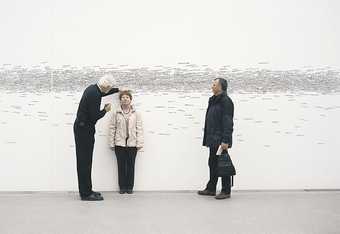
Roman Ondak
Measuring the Universe 2007
Presented at Tate St Ives, 2011
Courtesy of the artist
In the summer of 2011, Roman Ondak’s Measuring the Universe was installed at Tate St Ives. Upon entering an initially empty, white gallery, visitors were invited to have their height marked on the walls, along with their name and the date. Over the duration of the installation, the room was gradually filled with individual markings and names, overlapping and obscuring one another, to create a constellation of measurements. After the installation closed, the walls were repainted white, obscuring the moments of engagement with the performance, emphasising the ephemerality of the artwork as a whole, and of those brief moments of participation.
Ondak’s work functions on the level of the personal and of the public. The act of measuring the body – in the way, as Ondak points out, one measures a child as they grow1 – allowed participants to have an empirical measurement of themselves created which was entirely unique. On the other hand, when viewed as the repeated act of measurement, and displayed as the physical, visual embodiment of that – both in the marks on the wall, and on the visitors’ ability to observe one another participating – the work took on an acutely public aspect. Anyone visiting Tate St Ives during the three-month span of the installation, could impact on the work, depending on their height and where they chose to have their name marked. Those visiting the installation could also choose to focus on individual measurements, picked out and studied, or to observe the gradual creation of a collective pattern around the room. The private and the public became intertwined as the creators, the material and the observers of the evolving work.
The larger-scale repetition of Ondak’s work also speaks to this oscillation between the individual and the collective. Measuring the Universe was also presented at the Pinakothek der Moderne in Munich in 2007, MoMA in New York in 2009, the Stedelijk in Amsterdam in 2010–11, and more recently at Parramatta Town Hall, Sydney, in 2014 as part of the Sydney Festival. As the work is based on a set of instructions, rather than the creation of an object – after all, ‘measuring the universe’ is a continuous act – it can be seen as an extended performance, inhabiting different public spaces (often museums but, as seen in Sydney, not always) and capturing the measurements of groups of people in spaces across the universe. While the individual museums may document their iteration of the work, capturing the specific measurement of their audience in those moments, the collective work continues to exist, as the documentation of the performance builds. We are able to see, through photographs and videos, this process of measuring the universe, through the varied participations of public museums and the diverse people who exist within them.
Overall, Ondak’s work is created, through his installation instructions, by the universal understanding of the act of being measured as an individual, and as seeing that measurement as part of a larger collective action. It is a work which is simultaneously about process and product, with a focus both on the act of marking visitors’ heights on the gallery wall, and the shapes and patterns that collective participation creates. In participating, visitors to the installation perform both the act of being measured, and the act of positioning themselves within the ‘universe’ which Ondak seeks to capture. The ultimate ephemerality of the work’s material – the actual measurements – indicates that it is not about what the measurements show as quantifiable data, but about what it means to try and measure the universe through the people who compose it.
Acatia Finbow
September 2016
